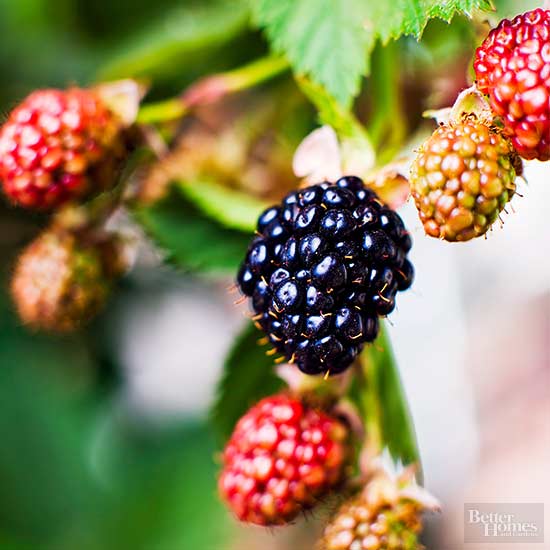






Delicious blackberries, rich in vitamin C, antioxidants, and fiber, are easy-to-grow fruits that sprout from stalks called canes.
Consider four qualities when choosing a site for growing blackberries. Start with sun. Blackberries produce the most fruit when they're planted in a space that receives 8 hours or more of direct sun per day. They can tolerate partial shade -- 6 hours of sun -- but don't do well in total shade.
Second, situate blackberry plants in soil that drains easily. If your soil is composed of heavy, moisture-retaining clay, prepare the blackberry bed by digging organic material such as compost into the top 8 to 10 inches when the soil is dry.
Third, choose a location where you have plenty of space for these vigorous growers to roam. New plants are formed from underground suckers that may pop up several feet from the mother plant, forming thickets of growth.
Finally, keep your new blackberry bed at least 300 feet away from raspberry beds that may host diseases or pests. Avoid planting in soil where tomatoes, potatoes, eggplants, or peppers have grown in the past two years, as the soil may harbor verticillium wilt disease.
continue reading belowAlways choose a blackberry bush that survives winters in your region. Carefully check the USDA Hardiness Zone ratings for the blackberries you buy, especially online. Your local nurseries are likely to carry blackberry plants hardy in your area. If you live in southern Minnesota, for example, and plant a blackberry rated Zones 6-10, you'll be disappointed; buy a blackberry variety rated Zone 3.
Blackberries grow on perennial plants that send up strong woody stalks called canes. There are three major types of blackberries, each with a different growth habit: upright or erect, semi-erect, and trailing. All types benefit from the support of a trellis, especially trailing blackberries.
Many blackberry canes grow with sharp, strong prickles, mistakenly called thorns, but new "thornless" blackberry varieties are easier to harvest.
Especially if you live in a cool climate, you may want to choose a primocane blackberry type. Most blackberries produce immature canes the first year, bear fruit the second year, then die. Primocane blackberries bear fruits on second-year canes early in the growing season, followed later by berries on first-year canes.
There is no tree blackberry. If you see something like a blackberry growing on a tree, the fruit is probably a mulberry.
Although it's possible to transplant roots from an existing blackberry patch, it's best to start with plants that are certified disease free from a nursery.
Plant as early as you can work the soil in the spring. Dig a hole that's a bit larger than the width and depth of the roots, setting the tallest part of the roots 1 to 1-1/2 inches below ground level. Cover with soil. Space each plant 2 to 4 feet apart, depending on the type of blackberry you choose.
When growing new blackberry plants, keep the top inch of soil relatively moist the first two to three weeks until growth begins. Once plants are established, they need about 1 to 2 inches of rain or surface water per week.
All first-year blackberry canes should be left to grow with no pruning.
In early spring, before most growth begins, use a hand pruner to cut second-year canes to 3-1/2 to 4 feet. This encourages side branches to grow and keeps canes shorter so they don't succumb to heavy snowfall or wind. If side branches have already developed, clip those to 12 to 18 inches.
Damaged, weak, or canes that rub too close together can be removed entirely. Healthy canes can be thinned so they stand about 6 inches apart.
Once blackberries are harvested, the canes start to die. You can cut them back at the end of the growing season, but it's best wait to remove them until early in the following growing season to allow nutrients to move back to the roots and into the new canes that are produced.
Blackberries and black raspberries are in the same botanical family, Rubus, and they look quite a bit alike.
How can you tell the difference? Several ways. Let's start with the fruits. Ripe black raspberries pull away from the plant, leaving a white cone-shaped center behind and a little cavity inside the berry. Blackberries, which pull straight off the plant and have a flatter top with no indentation, keep that white core inside.
The leaves are about the same size and shape on both berries, but the bottoms of blackberry leaves are lighter than the upper sides, almost silvery white. Blackberry stems are ridged and usually green or tan, while raspberry stems are blue-green and rounded.
In general, blackberry prickles are much larger, but so-called thornless varieties are available for both plants.
Make a blackberry salad with creamy feta.
Copyright © www.100flowers.win Botanic Garden All Rights Reserved